Garlic is relatively easy to grow and requires plenty of sunshine and warmth for the bulb to ripen. However, growing it at home might be difficult if you don’t know the right rules.
Garlic plant wilts due to frost, overwatering, lack of sunlight, pest infestation like bloat nematodes and black bugs, and diseases like rust and white rot. To prevent this, you must provide your garlic plant with adequate sun, water, nutrition, and winter protection.
This article will explore the reasons behind a dying garlic plant, how to deal with and prevent the problems, and get bigger, healthier, and more flavorful garlic.
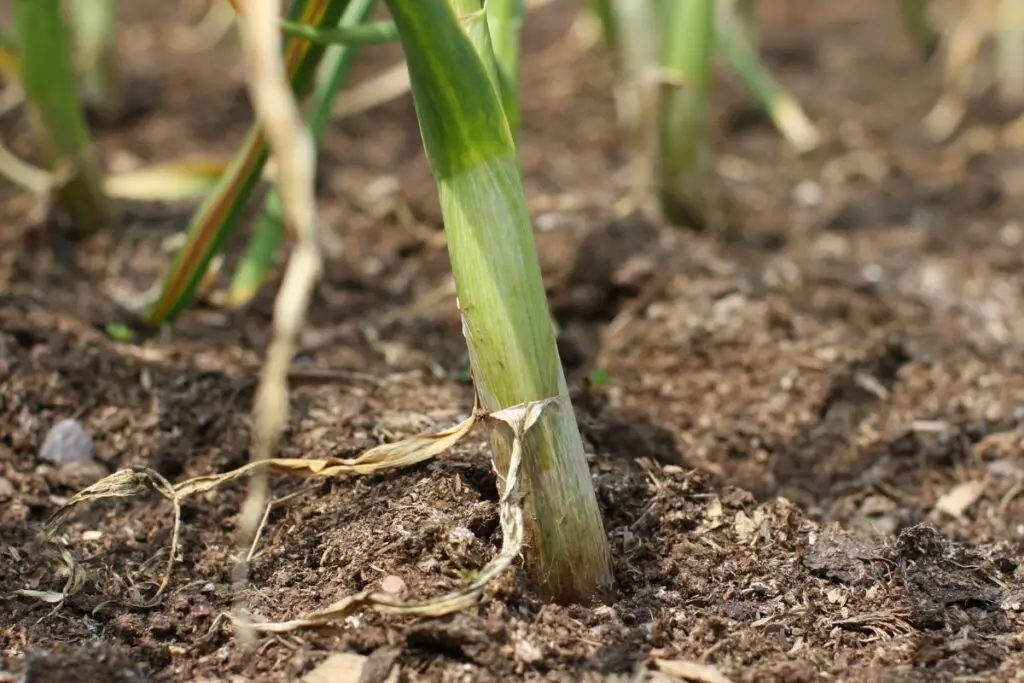
My garlic is dying – What should I know?
Garlic is one of the most popular vegetable plants used in making various dishes to add taste.
Besides, they are also beneficial for health.
Garlic is a hardy and easy-to-grow plant that requires bright full sunlight and warm temperatures to develop well.
They love moisture and nutritious soil to become more savory.
If you don’t give the garlic plants their requirements at the right time, you might see them end up dying.
For a beginner, it is tough to understand what problem the plant is facing.
If the plant has been distressed for a long time, it will display certain signs.
If you continue ignoring the signs and don’t treat them in time, your crop will die.
Signs that your garlic plant is dying
When garlic faces stress and starts to die, it will have some signs indicating its inferior health.
Some common signs are:
- Premature yellowing or browning
- Premature wilting and limp
- Leaves dying partially
- Uprooted plants
- Small, discolored, and deformed bulbs
- Wilted and dead leaves
When you find any of these signs, consider identifying the problem and then take action to revive your plant back to life.
Why is my garlic plant dying?
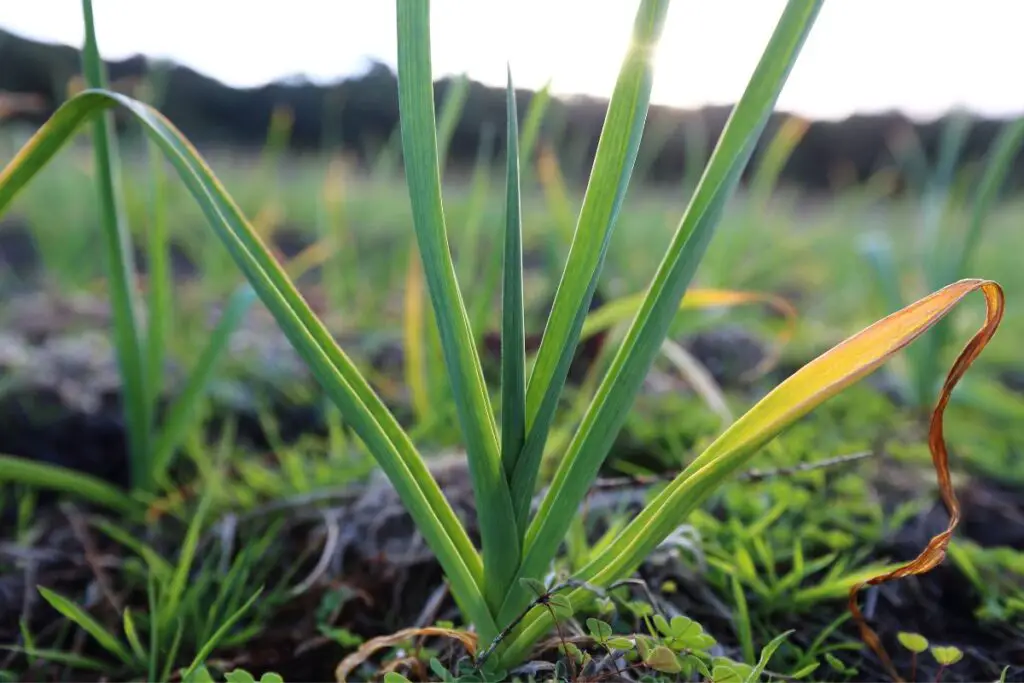
There are many reasons behind a dying garlic plant.
You first need to understand and identify the signs to treat your plant.
Then, it will be easier for you to fix the issues.
The best way is to find the initial signs and take immediate steps.
Below are some possible reasons behind dying garlic.
Looking for gardening supplies? We have tested 100's of products before recommending them to you guys. Check out our best pick below:
| Image | Gardening Supplies | Best Price? |
|---|---|---|
 Top
Top Top
Top | Raised Garden Bed Kit | Check On Amazon |
 | XLUX Soil Moisture Meter, Plant Water Monitor, Soil Hygrometer Sensor for Gardening, Farming, Indoor and Outdoor Plants, No Batteries Required | No Results |
 Top
Top Top
Top | 82 Pcs Garden Tools Set and Extra Succulent Tools Set | Check On Amazon |
 | Joeys Garden Expandable Garden Hose with 8 Function Hose Nozzle, Lightweight Anti-Kink Flexible Garden Hoses, Extra Strength Fabric with Double Latex Core, (50 FT, Black) | No Results |
 Top
Top Top
Top | Dual Chamber Compost Tumbler | Check On Amazon |
 Top
Top Top
Top | Sunnyglade Plant Stakes | Check On Amazon |
 Top
Top Top
Top | Organic Cold Pressed Neem Seed Oil | Check On Amazon |
 Top
Top Top
Top | Mighty Mint Gallon :-Insect and Pest Control Peppermint Oil | Check On Amazon |
 Top
Top Top
Top | Scotts DiseaseEx Lawn Fungicide | Check On Amazon |
 Top
Top Top
Top | Jacks Classic 20-20-20 All Purpose Fertilizer | Check On Amazon |
 Top
Top Top
Top | 30,000 Seeds Pollinator Attracting Wildflower Mixture | Check On Amazon |
 Top
Top Top
Top | Survival Vegetable Seeds Garden Kit-Over 16,000 Seeds | Check On Amazon |
Overwatering
Garlic likes consistently moist soil.
But that doesn’t mean you should create a pool of water around the plant.
The soil should be moist to maintain the plant’s hydration and not soggy or waterlogged.
Adding organic matter like compost or manure improves soil quality and moisture retention.
So, if you consider repeated watering, it will only create a pool around the plant.
Overwatering accumulates lots of water in the soil around the roots and suffocates them, thus making them unable to send the moisture and nutrients to other parts of the plant.
First, the leaves will become prematurely yellow, and then, the plant begins to die.
Overwatering also happens when you use heavy soil lacking ingredients that help drainage, like sand or perlite.
Another reason is the winter season.
Garlic doesn’t require winter watering because it stays dormant in the frozen ground.
Besides, the soil bed has a thick layer of mulch, which helps trap the moisture.
Watering in winter will only cause overwatering.
Also read: How Much Water Do Garlic Plants Need? (+How Often)
How to save the plant from overwatering?
When you find the initial signs like premature yellowing or drooping, consider checking the soil.
If it’s wet, let the soil dry for some more time.
Sometimes using clayey soil can cause this issue.
Clay soil is not good for garlic.
But you can still plant the cloves in such a kind of soil if you could manage the watering habits well.
Before watering the garlic plants, let the top few inches of the soil dry out.
Check the soil now and then when it’s time for water to confirm the dryness.
You can use raised beds.
It doesn’t accumulate water and thus helps control overwatering.
Avoid watering the garlic plants in the winter season.
A dormant vegetable plant will not take water while sleeping.
Besides, the mulch you add traps the moisture in the soil throughout the winter and doesn’t let the soil completely dry.
It would be best to reduce the watering frequency also during the rains.
Water garlic every 10-15 days if your region receives rain.
Underwatering
To save the plant from overwatering, people don’t water the garlic plants properly.
As a result, they end up underwatering the plant.
Garlic enjoys consistently moist soil.
The soil should remain well-drained but also retain water to some extent.
It mostly happens in the summers when the weather is too scorching, and you don’t water well.
Dehydration causes premature yellowing.
Over time, the leaves will wilt, and the plant will die due to this prolonged stress.
Poor retentive soil also causes underwatering because it cannot hold the moisture for long and drains before the plant can absorb it.
Besides underwatering, your garlic will also suffer from nutrient deficiency as it cannot hold nutrients.
How to save the plant from underwatering?
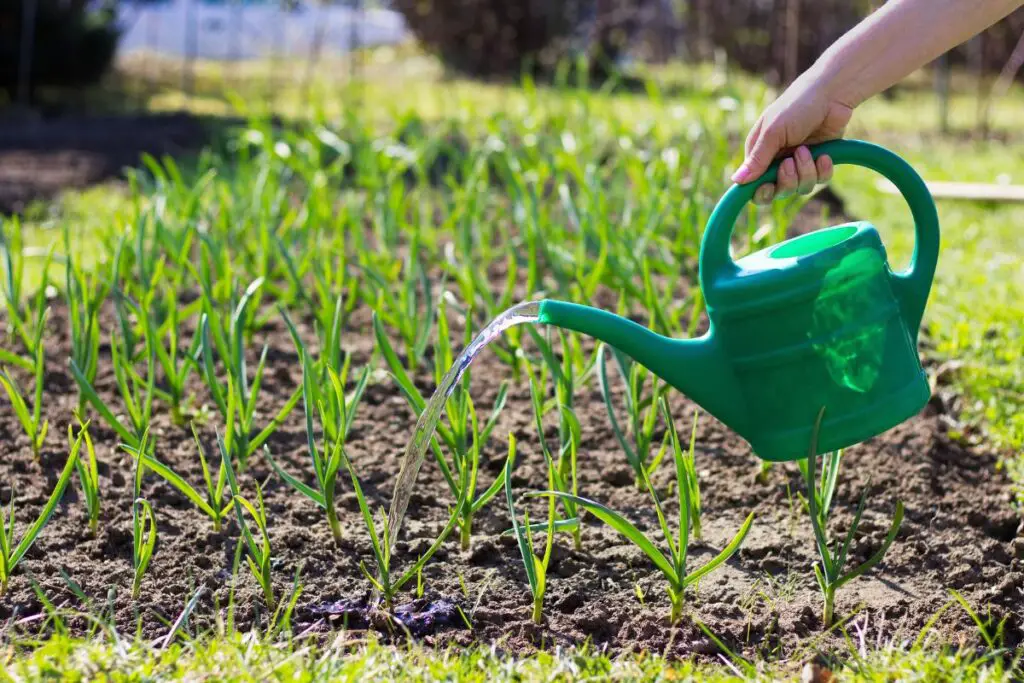
The soil you use should also be good in moisture retention, like drainage.
So while you select or make a well-drained soil, check its retention qualities.
Adding compost and manure can increase the retention qualities.
Water the plant every 3-5 days.
The frequency should be increased if the weather is too hot and there has been no rain.
Check the soil and water the plant whenever necessary.
Frost heave
Frost heave is a condition where the plant suffers from repeated frost temperature and soil defrost.
The temperature sometimes warms up in winter, so the soil warms up, and garlic starts growing.
Frost follows immediately after this warm temperature.
This fluctuation in the temperature can crack the soil, thus causing the plant to uproot and soil displacement around the tender roots.
This condition can stop the plant from developing, harm the tender roots, and kill the plant.
How to save the plant from frost heave?
Mulching or covering the soil will save the plant from frost heave.
The mulch or the covers can keep the ground cool if the weather ever gets warm and stop the garlic bulbs from growing.
The mulch or cover will protect them from the harsh frost if the weather is too cold.
Also read: Will Garlic Survive Frost? (+Protect Garlic From Cold Weather)
Frost damage
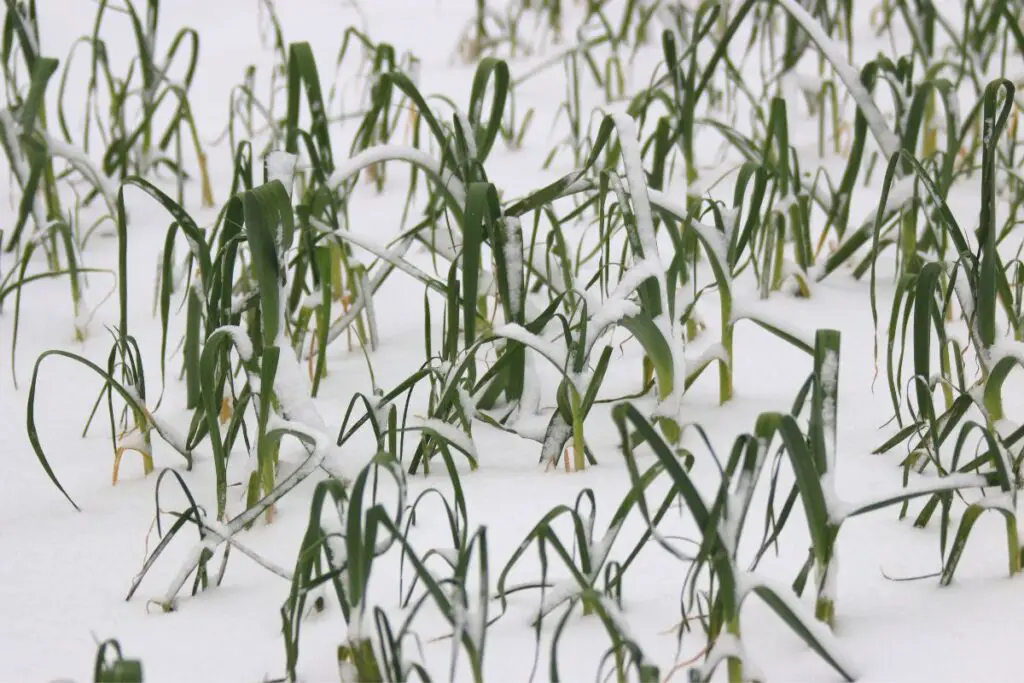
Generally, garlic plants are excellent frost-tolerant plants.
They can tolerate nearly -30°f temperature ranges.
But it will still receive frost damage if you fail to cover the cloves or mulch them in the winter.
The harsh frost will displace the soil around the tender roots and tear and kill them.
And dead roots mean dead plants.
The chances are more for some Softneck varieties.
They are native to the warmer zones of 8-11.
Sometimes, the garlic tops will also die if you don’t cover them.
However, it grows back when the weather gets normal.
How to save the plant from frost damage?
Mulching and covering have great benefits.
Covering the garlic cloves with mulches will stop the harsh frost from reaching the tender roots and kill them.
It also prevents the soil from getting displaced and tearing the roots.
Besides mulching with dry leaves, pine, and grass clippings, you can cover the cloves with agro fiber, plant stems, or sawdust.
Though the cloves and seeds need cold weather to trigger bulb growth and germination, you should still mulch them to stop the harsh frost from hurting the tender roots.
Garlic bloat nematodes
Nematodes are some microscopic worms that stay inside the stems and garlic bulbs.
These bugs will reproduce inside the plants and feed on the garlic bulbs, leaves, and stems.
Bloat nematodes can stay in the soil for years without water.
Since they stay inside the bulbs and plant, they are hard enough to get rid of.
If the infestation is small, the plant can tolerate the infestation to some extent.
The bulbs will be discolored and deformed.
If the population increases too much, the bugs can destroy all the crops and kill all the plants.
The bad news is, by the time you detect the problem, it’s late as the damage is already done.
How to save the plant from bloat nematodes?
To save the plant from nematodes, you must first get rid of them because it invades the plant and harms the garlic seeds and cloves.
Since the worms enter the plant, there are very rare solutions to the problem.
Sometimes, no solution is left, especially when the infestation is large.
To save the bulbs, you can wash them with hot water to control the population.
Cook the bulbs at 100°F with water for 30 minutes.
Don’t use very hot water as that will affect germination.
Garlic black bugs
These bugs are small black bugs and love feeding on the garlic plants.
You can identify them as black spots all over the garlic plants.
The parents lead their young babies to stay on their plants and feed on the plant parts.
The black bugs produce their young babies every couple of days.
It means that their population can enlarge and become uncontrollable within no time if ignored.
The plant will:
- Develop yellow leaves
- Stop growing
- End up dying
How to save the plant from black bugs?
To save the plant from a black bug infestation, spray the attacked areas with insect spray from your local gardening store.
These bugs are hard to control since they reproduce every couple of days, and the population increases faster.
After spraying and removing the bugs, you may have to move and rotate your garlic plants to some other place.
You can replace the space after removing garlic plants with other vegetables.
But make sure the vegetables are not from the allium family.
These bugs tend to attack allium more.
Continue this for 1-2 seasons.
The black bugs will leave the place once they realize their food source no longer remains.
Thrips
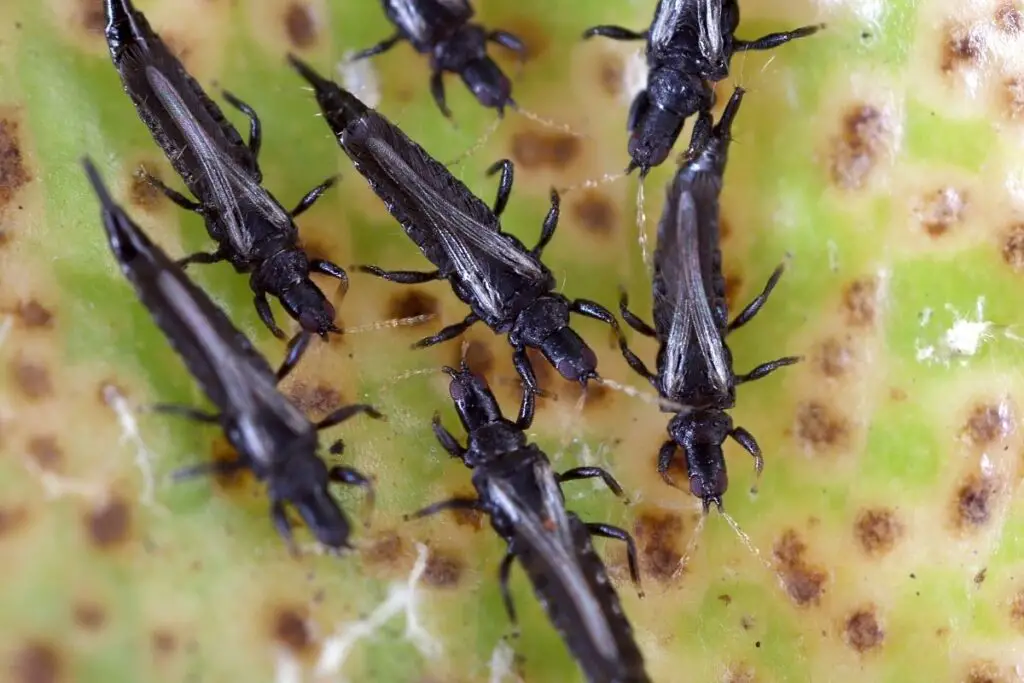
These bugs are the common insects found in all gardens.
Thrips pierce the leaves to suck their sap.
Over time, the leaves will run out of nutrients and moisture; the plant will slow down its growth and bulb production.
If the infestation is huge, it will make the plant wilt and die.
Thrips attack the garlic fields when the weeds in the nearest fields begin to dry.
How to get rid of thrips?
You can use sticky traps to control the thrip population.
Consider crop rotation to keep your garlic weed-free.
Thrips move from weeds to the garlic plants faster.
Water the garlic from above to remove the thrips.
Thrips enjoy hot and dry weather.
Watering can interfere with their peaceful stay in the plant.
Release natural predators like ladybugs, lacewings, parasitic wasps, and small pirate bugs.
Plant some deterrent plants like dandelions, dill, coriander, and fennel flowers to prevent the incoming thrips.
Apply insecticidal soaps like Bonide, spinosad, or neem oil spray.
Rust
You will find small orange/yellow and white specks all over the leaves and stems of garlic plants.
The dots will turn into long pustules.
If the problem persists for a long time, it can kill the whole plant.
How to remove rust from garlic plants?
The best way to get rid of rust from the garlic plants is to snip off the leaves when you spot the white or yellow leaves.
Throw those leaves into the dustbin, and don’t use them for composting.
The fungus grows in cool weather with low light and humidity.
To prevent the disease, give the garlic plants adequate warmth and sunlight.
Avoid watering the plant for some time and let the top few inches of the soil dry out.
Rotate your garlic plants, and don’t plant any allium crops in the affected area.
White rot
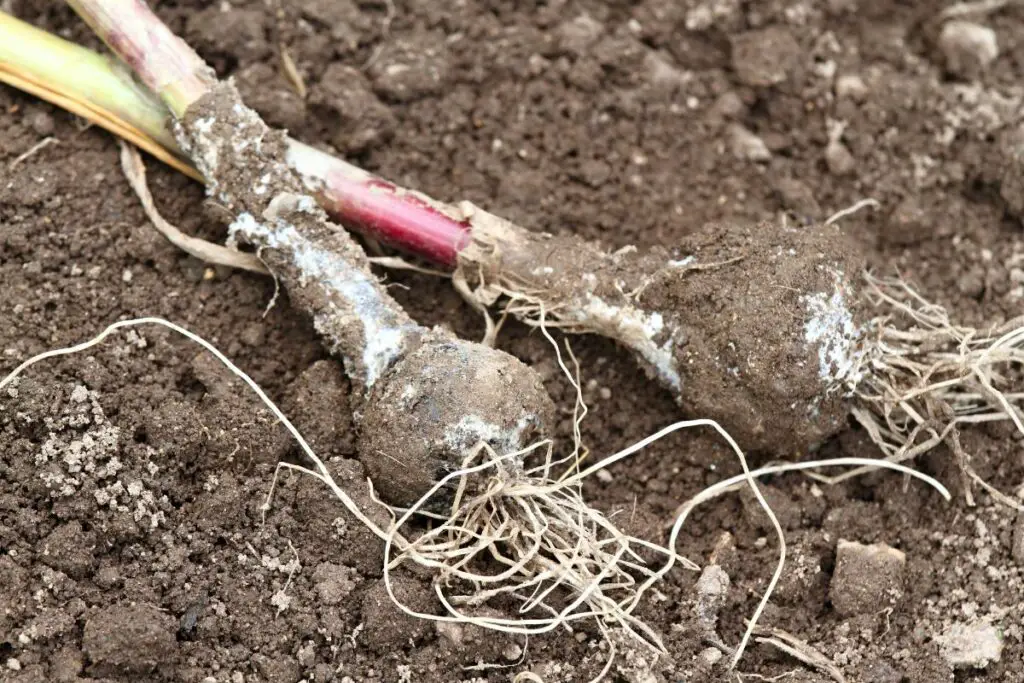
The signs are the same as the basal rot, but white rot is more harmful than basal rot.
The pathogens will decompose the leaves and the roots.
First, the old leaves will become yellow, and then all the leaves will get infected.
The plant will reduce its growth and then die.
You will find a soft white growth on the bulbs’ base.
Over time, your plant will die, and all the crops will get destroyed.
Also read: Problems With Garlic Plants (Yellow, Brown, Drooping, Bugs, & More)
How to save the plant from white rot?
White rot is quite a serious issue.
Fungicides are not always effective.
However, you can still use them.
Long-term crop rotation can help.
The best way to prevent this problem is to follow the right care tips and buy certified and healthy bulbs and seeds.
Sometimes, the cloves or the seeds get pre-infected with the pathogen, and the rot occurs over time.
You can dip the cloves or seeds in water heated at around 115°F.
Let the plant have adequate sunlight and warmth.
It can deter them to some extent.
Water the plant when a few inches of topsoil has dried.
Final thoughts
Garlic plants are easy to grow and harvest with adequate care and maintenance.
Give them enough sunlight for 6 hours per day. Water them well to keep the soil moist. Use well-drained soil with organic matter. But certified and healthy bulbs and bulbils. Mulch them in the winter to prevent the harsh frost from harming the tender roots.
Check for pests and take immediate action to remove them. Avoid situations that attract pests and diseases like overwatering, less sunlight, and high humidity.
Reference: The Pennsylvania State University, Garlic Production for the Gardener, University of Massachusetts Amherst, Ohio State University Extension.
